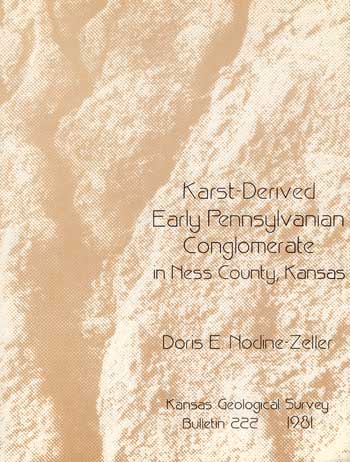Karst-Derived Early Pennsylvanian Conglomerate in Ness County, Kansas
Abstract
Beds encountered in a continuous core from the Mid-Continent No. 1 J. G. Collins borehole, Ness County, Kansas, include a Pennsylvanian breccia-conglomerate of Atokan or lowermost Desmoinesian age, with reworked upper Morrowan or Atokan limestone in a conglomerate or possibly a deeply weathered subsoil zone; a paleosol; a pebble conglomerate of Cherokee age; Cherokee shale beds representing transgressive-regressive marine episodes; and a normal marine limestone (Fort Scott) of early Marmaton age. Beds at the bottom of the core rest upon the upper, weathered surface of the Mississippian limestone (Osagean). The breccia-conglomerate contains a mixture of weathered-in-place cobbles and boulders and riverine pebbles and cobbles of Osagean, Meramecian, and Chesteran ages derived in part from an extensive, deeply weathered karst terrain. The chaotic nature of the matrix beds (composed mainly of fresh and white chalky chert; spicular chert; drusy and doubly terminated quartz crystals; white beekite rings; rounded, frosted and clear, angular sand and silt grains; gray and green clay residuum, and minor amounts of sphalerite and chalcopyrite) represents the mixed weathering products derived from reworking of Mississippian beds in the matrix of the breccia-conglomerate. Also in the enclosing matrix are beds at several levels with carbonized plant remains and coaly fragments of Morrowan or Atokan age and a distinctive white sandstone conglomerate below the weathered soil zone. A cross section, with base of the Fort Scott Limestone as datum, shows correlation of three of the overlying units above in the vicinity of the No. 1 Collins borehole. Variation in thickness of the "basal Pennsylvanian conglomerate" leads to difficulty in picking the top of the "Mississippi solid."
Fusulinids, endothyrids, archaediscids, conodonts, and algae were used for age determination and to interpret succession of stratigraphic, geomorphic, and structural events. These karst-related events can be compared with those that took place in Texas, Oklahoma, Missouri, Kansas, Colorado, Wyoming, Montana, and the southwestern United States during about the same time and that involved the same stratigraphic units. This Mississippian karst horizon is important as a host rock for the emplacement of lead, zinc, and silver ores and as a stratigraphic trap in the accumulation of petroleum and natural gas.

